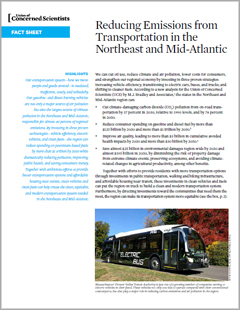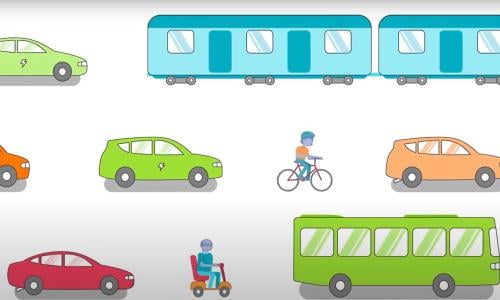We can build a clean and modern transportation system for the region that will cut oil use, reduce climate and air pollution, lower costs for consumers and strengthen our regional economy. By investing in increased vehicle efficiency; a transition to electric cars, buses and trucks; and a shift to cleaner fuels, Northeast and Mid-Atlantic states can:
- Cut climate damaging CO2 pollution from on-road transportation by 37% by 2030 and 78% by 2050
- Reduce consumer spending on gasoline and diesel fuel by more than $1 trillion by 2050
- Improve air quality, leading to more than $3 billion in cumulative avoided health impacts by 2030
- Save billions of dollars in environmental damages region-wide by 2050
Improvements in fuel efficiency
Northeast and Mid-Atlantic states can support strong federal and California standards to accelerate emissions reductions and fuel efficiency after 2025. When we invest in cutting emissions from vehicles and fuels, we’re building a better future where everyone can get to where they need to go.
Electric cars, buses, and trucks for everybody
Electric vehicles (EVs) help move us away from petroleum-based fuels and are increasingly available in all vehicle classes and models. Achieving widespread adoption of electric vehicles by 2050 requires sustained investments to incentivize switching to EVs, especially for low and moderate-income residents. The transition to EVs could save ratepayers almost $138 billion by 2050.
Lower carbon fuels
In addition to EVs, cleaner transportation fuels help to reduce carbon emissions. Clean fuels can be made by blending low-carbon biofuels into gasoline and diesel. This could lead to a 30 percent reduction in carbon emissions per unit of transportation fuel by 2050.
Moving forward
Reducing transportation emissions will bring dramatic financial, environmental, and health benefits. Northeast and Mid-Atlantic states are posed to be leaders in creating this modern, energy-efficient, and low-emission transportation system.
It is crucial that states continue to seek diverse stakeholder and public input. New investments in solutions should prioritize air quality improvements in communities exposed to disproportionate levels of pollution; ensure access for those with limited mobility options, such as rural residents, elderly people, and people with disabilities; and ensure good jobs with necessary skills training to diverse communities. Forward-thinking policy leaders combined with robust community engagement can ensure a truly modern, equitable, and reliable transportation system that works for everyone.
This fact sheet was produced thanks to an analysis conducted by our partners at MJ Bradley & Associates. Download the full report for the in-depth analysis. See the technical appendix and the boxes below for key calculations by state.
Click on the links to view the costs and benefits of each state.
Connecticut | District of Colombia | Delaware | Massachusetts | Maryland | Maine | New Hampshire | New Jersey | New York | Pennsylvania | Rhode Island | Virginia | Vermont




